The Prize
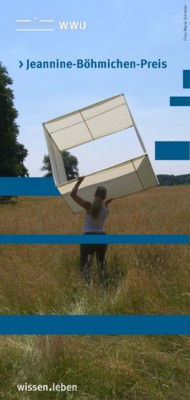
© Buttschardt/Schreiter The institute for landscape ecology assigns since the year 2018 the Jeannine-Böhmichen-Prize for an outstanding Bachelor thesis in the study program in Landscape Ecology (B.Sc.). The prize is awarded annually and is endowed with 400 Euro.
The prize is awarded for a bachelor thesis that, among other things, presents complex issues in landscape ecology in a clear and concise manner, independently raises questions of high originality or up-to dateness, presents complex information in a clear and concise manner and demonstrates the creative scope of students.
The prize rewards particularly committed students with their final thesis and at the same time reminds of Jeannine Böhmichen, who studied landscape ecology in Münster and died in an accident in 2016.
The prize money comes from a foundation of parents, relatives and friends of Jeannine.
If possible, the prize will be presented at a festive event of the faculty (Graduates' Day, Young Researchers' Day or similar). The award winners are invited to give a short presentation about their work at this event.Donations are possible and desired. Please contact the address below for further information.
How to apply
For the Jeannine-Böhmichen-Prize all students can apply, who are/were enrolled in the B.Sc. Landscape Ecology of the University of Münster and wrote their Bachelor thesis there. The thesis should have been written in the current or previous academic year. Even if the self-application of students is intended, the supervisors are called upon to address suitable students and encourage them to submit their thesis.
Applications should be submitted electronically by 12.10. to the following address:
jeannine.boehmichen.preis [at] uni-muenster.deThe Jury
The applications are evaluated by a jury, which includes members of the Böhmichen family, the Institute for Landscape Ecology as well as active and former students of landscape ecology.
The legal process is excluded.Application deadline in 2024
October 12 2024
Mandatory documents
- Cover letter
- Copy of the (preliminary) diploma
- a two- to three-page extended summary
- In the case of a thesis written in English, an abstract in German
- Bachelor thesis
Jeannine Böhmichen Prizes awarded
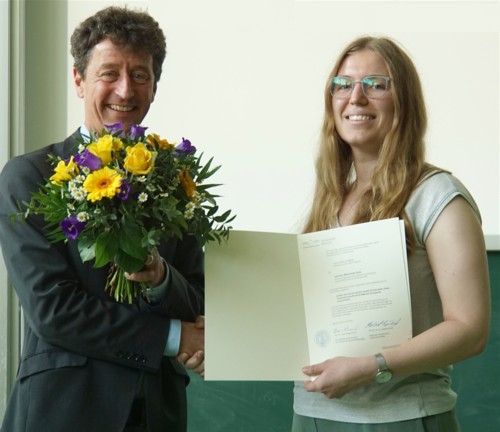
© FB14 The Jeannine Böhmichen Prizes were awarded during the Geo.Science.Day on 15 June 2023. The prize is awarded to a Bachelor's thesis that, among other things, presents complex issues from landscape ecology in a clear and concise manner, independently raises questions of high originality or topicality, presents multi-layered information in a clear and concise manner or demonstrates the creative scope of students. As a rule, only one prize is awarded per academic year.
Prof. Dr. Tillmann Buttschardt gave the laudatory speech and presented the
the award certificate to Hedda Lil Müller. She received the award for
her Bachelor's thesis on the topic: "Growth rate and microplastic uptake of fresh water ciliate Tetrahymena pyriformis at different microplastic concentrations".
We warmly congratulate the award winner!The prizewinner 2023
In 2023 Hedda Lil Müller received the award for her Bachelor's thesis on the topic:
Growth rate and microplastic uptake of fresh water ciliate Tetrahymena pyriformis at different microplastic concentrations
Summary
In the context of ongoing plastic pollution in the environment, the impact of microplastics on microorganisms is of great importance for gaining knowledge about potential effects of microplastics on aquatic ecosystems. While it is known that aquatic organisms can ingest microplastic particles, many of the resulting effects on behaviour and physical characteristics are still not well studied. Furthermore, these effects might differ depending on the amount of ingested microplastic.
In order to analyse the potential influence of microplastic ingestion on an aquatic microorganism, the ciliate Tetrahymena pyriformis was exposed to different concentrations of 4 μm polystyrene microbeads for 24 hours. The number of ingested microbeads was microscopically observed and the population growth rate after 24 hours was examined. A functional response model was fitted for the feeding rates at di↵erent microplastic concentrations and linear regression was performed to analyse the effect of microplastic concentration on growth rate.
The ciliates generally ingested a higher number of microbeads at high concentrations of microplastics, but showed a decrease in ingested particles after 24 hours. A possible explanation for this might be the ciliates learning to avoid non-nutritious material. The analysis of the feeding rates at di↵erent microplastic concentrations resulted in a Type II functional response. Additionally, the calculated growth rate decreased by 28.5 % from the lowest (0 beads per ml) to the highest (2,000,000 beads per ml) concentration of microplastics. It seems possible that the ingestion of non-nutritious particles leads to a decrease in energy, which is essential for effective reproduction and cell growth.The prizewinner 2022
In 2022 Isabelle Walgarth received the award for her Bachelor's thesis on the topic:
The effect of riparian strips of different widths on the the ecological condition of an agriculturally shaped watercourse
Summary
The ecological status of surface and groundwater in North Rhine-Westphalia has deteriorated significantly due to multi-layered anthropogenic intervention since industrialisation. This negative development is to be counteracted in catchments with extensive agricultural land use with the use of riparian strips (GRS). Environmental legislation (Water Resources Act and Fertiliser Ordinance) implies that the buffer properties of width, vegetation density, site-appropriate vegetation composition and the slope of a GRS improve the ecological status of a watercourse. The extent to which the width and other riparian attributes of a GRS - in addition to existing shading - improve its buffer effect was investigated on the basis of six study sites of a watercourse in the agriculturally dominated Lippe sub-basin. The GRS of the six study sites (50 m each) were qualitatively assessed by the Riparian Habitat Index (RHI) of Burdon et al. [2020] and compared with the indices of the macrozoobenthos quality component (Perlodes assessment system). Furthermore, the occurrence of macrophytes was investigated and a water sample was taken from each site to determine the trophic status - especially with regard to the content of orthophosphate, nitrate and ammonium. Here, the influence of the surrounding small sewage treatment plants and the substance input from the upper reaches through an official measuring point upstream of the study area were taken into account. The results showed that especially the bank attributes bank stability and vegetation density, followed by buffer width, buffer intactness and slope effectively improve the effect of GRS in the study area. The results in the study area showed that the design of GRS should be based on the conservation objectives (ecosystem services) of the particular site. Accordingly, risk areas for sediment shift and nutrient input should - especially in the upper reaches - preferably be managed with wider and densely vegetated GRS, with vegetation being removed once a year by mowing. The implementation of locally communicated approaches could be promoted by the extended regulatory possibilities of the authorities [LWG, 2022] and the advice from the Chamber of Agriculture.
The prizewinner 2021
In the year 2020 Hanna Schlüter and Svenja Hirsch were awarded for her works.
Hanna Schlüter
Comparison of a renaturalized and straightened section of the Hessel river, based on ecosystem functions using the example of organic matter degradation
Many watercourses in Germany are in a degraded state. For this reason, the European Water Framework Directive (WFD) has existed since 2000 with the aim of restoring surface waters to an ecologically good condition. In this study, a section of the Hessel River that had been developed and a section that had been renaturalised in 2013 were compared. Two series of tests were carried out (on the banks and in the middle of the watercourse). Sample bags with two different mesh sizes, filled with leaf material, were positioned. The coarse-meshed bags allow colonisation of the leaf material by macroinvertebrates, the fine-meshed bags exclude colonisation by macroinvertebrates and exclusively demonstrate the degradation process by microorganisms. In the second series of experiments, the influence of the flow on the degradation of the leaf material was to be explicitly investigated. The mass loss of the leaf material was monitored weekly. In addition, the macroinvertebrates that colonised the samples were determined and counted at large group level. In addition, flow velocity and water temperature were measured at each sampling to take into account the influence of abiotic parameters. The results were then compared with the results of previous bachelor theses in order to assess the success of the restoration measures.
By comparing the results from 2013 and 2017, it became clear that the similarity of the river sections (developed, renatured) can be explained by a positive effect of the renatured section on the developed section and that the renaturation success can be demonstrated.
Svenja Hirsch
A citizen science approach carried out by children to measure the impact of mulching on soil quality according to the goals of Education for Sustainable Development
Citizen science creates new possibilities for collecting data in nature conservations and can potentially become a regular element in school education. Within the framework of the present bachelor thesis a citizen science approach consisting of 7 experiments to measure the impact of mulching on soil quality, which can be carried out by 5th and 6th grade students, was developed. The objectives of Education for Sustainable Development (ESD) were taken into account while developing the concept.
The evaluation of the concept by piloting it at a school shows that some of the experiments are suitable for data collection by children. Other experiments show more problems in data collection by children as the results differ more. To answer the question whether the students are able to collect useful data for science, a more comprehensive evaluation with a larger sample size is needed. In addition, piloting the concept shows that 5th and 6th grade students are motivated to participate in citizen science projects. Citizen science projects can have positive effects on student learning. From hands-on activities and time in nature while collecting data, students' interest in scientific research and the natural environment of soil can be sparked. Furthermore, the children made positive experiences with collaborative teamwork. A more comprehensive impact analysis is needed to capture the effects of the concept on students' learning and actions. By connecting Citizen Science and ESD, the developed Citizen Science concept for measuring the effect of mulch management on soil quality by children offers an added value to previous ESD or Citizen Science projects.The prizewinner 2020
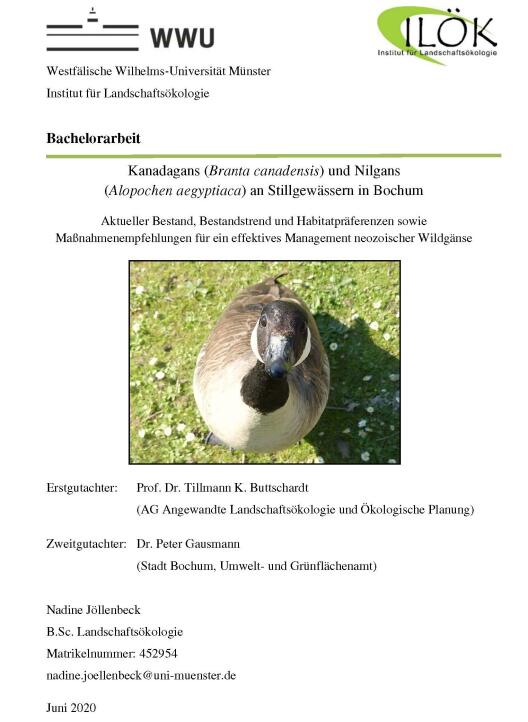
Title B.Sc. Theses Nadine Jöllenbeck© Jöllenbeck In the year 2020
Nadine Jöllenbeck
was awarded for her work on the topic:Canada Goose (Branta canadensis) and Egyptian Goose (Alopochen aegyptiaca) at ponds and lakes in Bochum (North Rhine-Westphalia). Current population, population trends, habitat preferences and recommendations for an effective management of neozoic geese.
Summary
Populations of non-native Canada Goose and Egyptian Goose have spread significantly in North Rhine-Westphalia – also in the municipal area of Bochum – for the last recent years. To investigate the ecological and environmental effects of neozoic geese populations in Bochum, an inventory of waterfowl at ten different lakes and ponds has been conducted. For Canada Goose, an average population size of 209 adult birds and 104 breeding pairs were counted with a high population density at many water bodies. Moreover, 60,5 adult Egyptian Geese on average and a breeding stock of 22 pairs were detected. The Egyptian Goose has obviously not reached its optimum in density yet. Basing on breeding stocks and biological factors, the population trends of Canada Goose and Egyptian Goose are positive, but for Branta canadensis the trend is more exponential than for Alopochen aegyptiaca. Possibly, the Canada Goose has reached its maximum at some ponds yet. Water bodies right nearby open areas with short grass lawn and meadows used for grazing are preferred habitats by both of the investigated geese species. Breeding sites on islands are preferred by Canada Geese, but at urban ponds with high population densities, broods at unprotected sites next to the footpath were also recorded. For Egyptian Goose, no preferred breeding sites could have been determined. No negative effects of neozoic geese on autochthonous waterfowl were observed. It should be examined by future investigations whether further population growth is a threat to native species. As a result of population growth of Canada Goose and Egyptian Goose and frequent complaints by visitors in parks, the management of these geese can be inevitable. Cleaning of pathways and lawns as well as the creation of barriers or long-grass meadows could provide effective non-lethal methods to generate spacial control and minimize fouling of urban parks and green spaces caused by geese. Best long-term effects in reducing geese populations showed managements by egg removal. A continuous and regularly monitoring of all waterfowl species should be conducted as a basement for all future approaches regarding the efforts on geese population management.
The prizewinner 2019
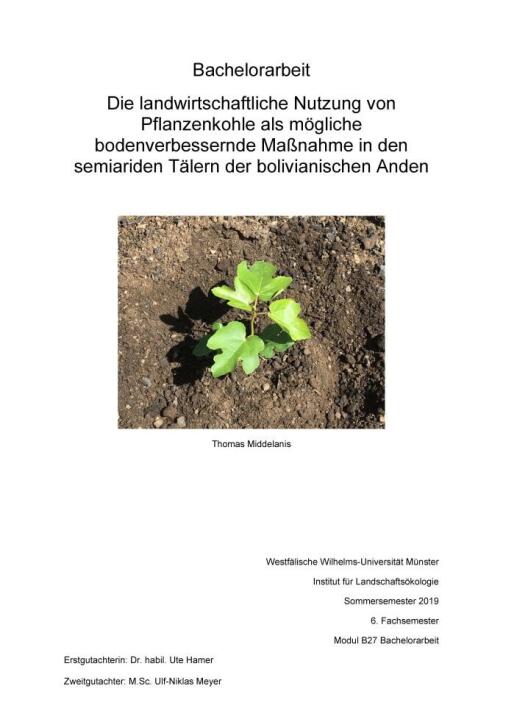
Title B.Sc. Theses Thomas Middelanis© Thomas Middelanis In the year 2019
Thomas Middelanis
was awarded for his work on the topic:
The agricultural use of vegetable coal as a possible soil improvement measure in the semi-arid valleys of the Bolivian Andes
Summary
The agriculture of the semiarid valleys in the Bolivian Andes faces grave challenges concerning actual soil conditions and climate alterations in the future. These oblige adjustments in the use of the basic resources water and soil plus adaptations of the agricultural practice in general. This bachelor-thesis examines whether the incorporation of biochar into soils is able to meliorate the local soil quality and prevent degradation processes. The biochar was produces in a Kon Tiki-oven just before the start of investigation (approximately 700 °C; < 1 hour duration of pyrolysis). Soil humidity, total nitrogen content, litter decomposition and basic soil parameters were chosen as indicators to measure the possible effects of the proposed treatment. The measurements took place between March and July of 2019 in an agroforestry parcel, which was implemented for the scientific purpose of this study. The study site is located in the research centre Mollesnejta in Cochabamba, Bolivia. The biochar treatments were divided into two groups of each 10 replications. Group 1 had a dosage of 25,8 kg biochar per m3, while the amendment of group 2 was the double, 51,6 kg/m3. In comparison to the control group both showed positive effects due to the biochar amendments on soil conditions: Biochar increased soil pH, electrical conductivity, potential cation exchange capacity, soil moisture and total nitrogen content. The effect on the lastmentioned parameter was significant (p < 0,05) and in the case of the biochar effect on soil water content highly significant (p < 0,001). The measurement of the litter decomposition rates showed no clear results. Apart from that, the results showed clearly positive effects of biochar on soil physical and chemical conditions. They were discussed and mainly explained by the structural properties of biochar, such as its high porosity and particular surface chemistry.
The prizewinner 2018
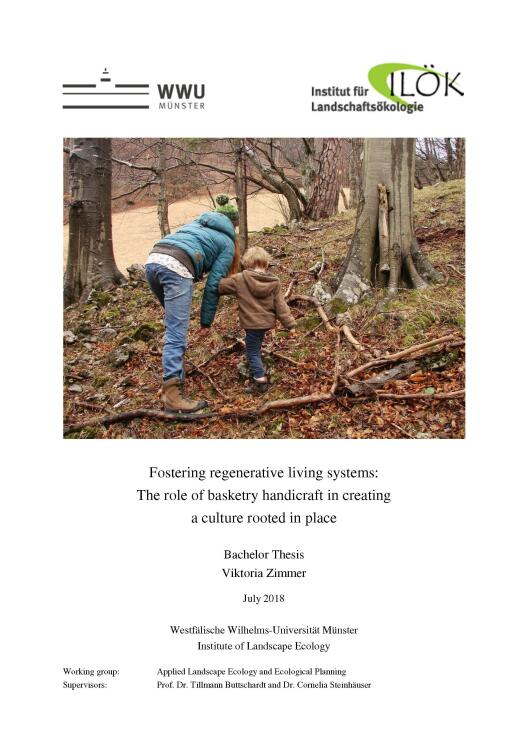
Title B.Sc. Thesis Viktoria Zimmer© Viktoria Zimmer In the year 2018
Victoria Zimmer
was awarded for her work on the topic:
Fostering regenerating living systems: The role of basketry handicraft in creating a culture rooted in place
Summary
Restoring the health of our largely degenerative social and ecological systems involves ac-knowledging how current ecological crises go hand in hand with people’s declining awareness of local ecosystems. As a neglected relationship with land represents a root cause of ecological degradation, it is vital to establish a human-place connection that is shaped by respect, reciprocity and responsibility. This thesis explores how consciously interweaving our lives with specific locations stimulates place attachment and the emergence of a culture deriving from the local landscape. The primary target of this thesis was to examine how the practice of basketry handicraft can support the transition towards regenerative (socio-ecological) living systems. The author argues that humans are an integral part of nature and that creating regenerative living systems requires a way of relating to places that acknowledges our interconnectedness. The first step of this research consists in conceiving a holistic framework of place attachment by merging the results of an interdisciplinary literature research with the 8 Shields Model, a natural pattern recognition tool. This created framework is then empirically investigated and specified by conducting semi-standardized interviews with five basketry practitioners from Austria, Germany and Switzerland. The resulting data is qualitatively analysed. Research findings confirm the initial assumptions that practicing basketry handicraft with local plant materials is associated with emotional bonding to, knowledge about, and an attitude of stewardship for a place. Further aspects of place attachment are identified, and the empirical research substan-tiates how cultivating place attachment can transform living systems towards being more re-generative by encouraging a culture rooted in place. The broad implication of the present study is that restoration efforts should involve the larger population and arise from the unique character of each place.
Jeannine-Böhmichen-Prize
for outstanding Bachelor theses in the study programme Landscape Ecology (B.Sc.)

